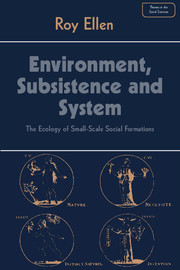Book contents
- Frontmatter
- Contents
- Preface
- Acknowledgements
- 1 ENVIRONMENTAL DETERMINISM AND CAUSAL CORRELATION
- 2 POSSIBILISM AND LIMITING FACTORS
- 3 CULTURAL ECOLOGY AND THE EXPLANATORY IMPERATIVE
- 4 HUMAN ECOLOGY AND THE BIOLOGICAL MODEL
- 5 THE FLOW OF ENERGY AND MATERIALS
- 6 ECOSYSTEMS AND SUBSISTENCE PATTERNS I
- 7 ECOSYSTEMS AND SUBSISTENCE PATTERNS II
- 8 SYSTEMS AND THEIR REGULATION
- 9 INFORMATION AND THE MANIPULATION OF THE ENVIRONMENT
- 10 ADAPTATION: A SUMMARY AND RECONSIDERATION
- 11 THE REPRODUCTION AND EVOLUTION OF SOCIAL AND ECOLOGICAL SYSTEMS
- 12 ECOLOGY IN ANTHROPOLOGICAL METHOD AND THEORY
- Notes
- Bibliography
- Name Index
- Subject Index
7 - ECOSYSTEMS AND SUBSISTENCE PATTERNS II
Published online by Cambridge University Press: 05 June 2012
- Frontmatter
- Contents
- Preface
- Acknowledgements
- 1 ENVIRONMENTAL DETERMINISM AND CAUSAL CORRELATION
- 2 POSSIBILISM AND LIMITING FACTORS
- 3 CULTURAL ECOLOGY AND THE EXPLANATORY IMPERATIVE
- 4 HUMAN ECOLOGY AND THE BIOLOGICAL MODEL
- 5 THE FLOW OF ENERGY AND MATERIALS
- 6 ECOSYSTEMS AND SUBSISTENCE PATTERNS I
- 7 ECOSYSTEMS AND SUBSISTENCE PATTERNS II
- 8 SYSTEMS AND THEIR REGULATION
- 9 INFORMATION AND THE MANIPULATION OF THE ENVIRONMENT
- 10 ADAPTATION: A SUMMARY AND RECONSIDERATION
- 11 THE REPRODUCTION AND EVOLUTION OF SOCIAL AND ECOLOGICAL SYSTEMS
- 12 ECOLOGY IN ANTHROPOLOGICAL METHOD AND THEORY
- Notes
- Bibliography
- Name Index
- Subject Index
Summary
In Chapter 6 I assumed a model of synchrony, and for many purposes this is acceptable and profitable. But variation in yield, effort and efficiency through time and its use and allocation between different activities may be of the greatest importance in understanding the operation of particular subsistence patterns, and in comparing populations.
YIELD, EFFORT AND EFFICIENCY OVER TIME
All populations experience differential availability of food, and therefore variation in consumption patterns, depending on phases of the agricultural calendar, the seasonal movement of animal species, growth cycles of animals, maturation periods of plants, and climatic and other temporally patterned ecological hazards. Figure 7.1 provides a simple example of this: the frequency of use of different foods in an African peasant population. Figure 7.2 gives a general indication of energy availability, consumption and expenditure over a period of one year for a Gambian population. From this it is clear that input of effort may also be closely tied to prevailing seasonal conditions. Nuaulu time spent in the gardens is correlated inversely with the amount of rainfall, and the difficulties of communication which this gives rise to (Ellen 1978:131–2). Clearly, efficiency will vary concomitantly, although balance is generally maintained over an entire cultivation cycle.
Patterns for the appropriation of non-domesticated resources may be similar. In their classic essay, Mauss and Beuchat (1979:55) were able to show how the seasonal availability of different animal species is directly linked to Eskimo patterns of nomadic movement and settlement (cf. Damas 1969, Rogers 1972, Thomson 1939).
- Type
- Chapter
- Information
- Environment, Subsistence and SystemThe Ecology of Small-Scale Social Formations, pp. 154 - 176Publisher: Cambridge University PressPrint publication year: 1982



